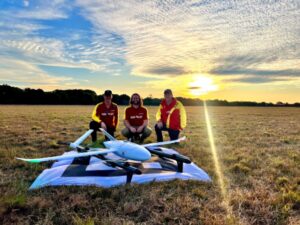
by DRONELIFE Staff Writer Ian M. Crosby
Due to the assistance of drone training specialist Aviassist, Surf Life Saving NSW’s Australian UAV Service could soon begin deploying long range drones to locate missing bushwalkers or people swept into rough seas. The technology was tested both night and day at Evans Head on the NSW far north coast, finding a pair of mock hikers who were “lost” in nearby scrubland.
The test flights saw four long range drones take turns searching for the missing hikers alongside 16 other scenarios, with the NSW government committing $1 million toward the 18 month-long Long Range UAV Project, which includes a week-long trial called the Long Range UAV Project Trial Week. SLSNSW is currently assessing whether the technology could be rolled out permanently, thanks to the help of Aviassist with regulatory approvals.
“This really is a gamechanger for surf life saving. Every second counts in these situations so if a drone can be launched with thermal cameras, a missing person, or group of people, can be found quickly and that can be the difference between life and death,” said Aviassist Managing Director Ross Anderson. “The technology is advancing so fast at the moment and that allows for more area to be covered in less time, so it’s there to be harnessed. Surf Life Saving NSW’s UAV Pilots are picking it up quite fast – there’s an enthusiasm there to upskill and ultimately save lives. Surf Life Saving NSW already has a fleet of more than 200 drones, making it the biggest of any surf life saving organisation in the southern hemisphere. Drones are more than tools, they’re teammates.”
Recently, Aviassist oversaw the first AI enabled drone flight in Australia from a ‘smart’ docking station around Sydney Harbour, in which the drone was able to navigate around pylons and buildings and detect the Harbour Bridge in the background. The Dock is claimed to be able to fly a drone in a five kilometer range and to within 11 centimeters of a foreign object. Though not a requirement, an individual can monitor the drone’s stream from anywhere in the world.
“It was only a matter of time,” said Anderson. “The drone was able to work out there were certain structures in the area and fly around them. It’s not autopilot, it’s AI. It was the drone summing up its surroundings and saying to itself, ‘hey, I can fly here, I can’t fly there’.”
Read more:
- Skydio AI-Empowered Drone Self Navigates in Flight Over Sydney Harbor, with First Deployment of Skydio Dock in Australia
- Australia’s Carbonix Completes First Commercial Flights in US with Volanti Electric Fixed Wing
- Australia Introduces 40 Question BVLOS Exam for Ops in Non-Controlled Airspace
- Clean Up Australia: Aerologix Drone Pilots Find Hidden Trash
Ian attended Dominican University of California, where he received a BA in English in 2019. With a lifelong passion for writing and storytelling and a keen interest in technology, he is now contributing to DroneLife as a staff writer.
Miriam McNabb is the Editor-in-Chief of DRONELIFE and CEO of JobForDrones, a professional drone services marketplace, and a fascinated observer of the emerging drone industry and the regulatory environment for drones. Miriam has penned over 3,000 articles focused on the commercial drone space and is an international speaker and recognized figure in the industry. Miriam has a degree from the University of Chicago and over 20 years of experience in high tech sales and marketing for new technologies.
For drone industry consulting or writing, Email Miriam.
TWITTER:@spaldingbarker
Subscribe to DroneLife here.